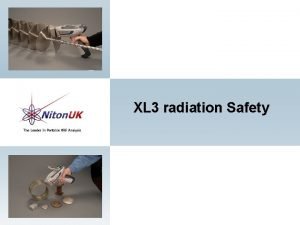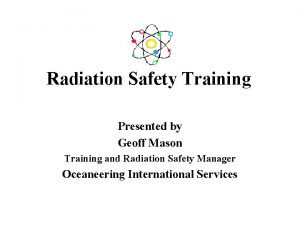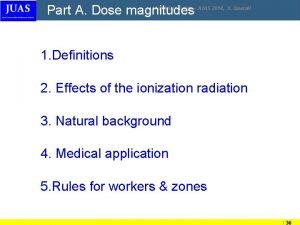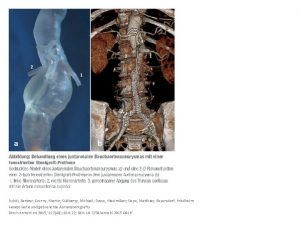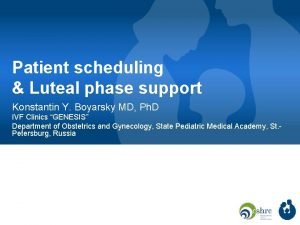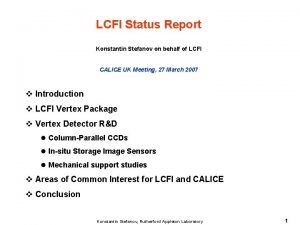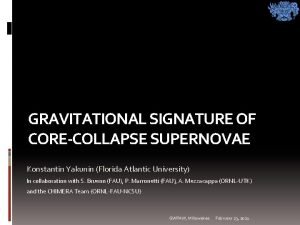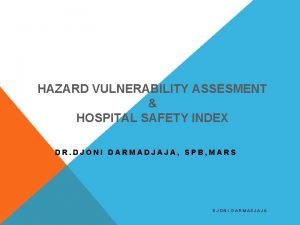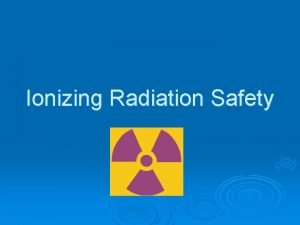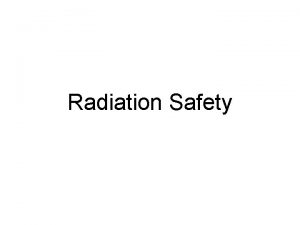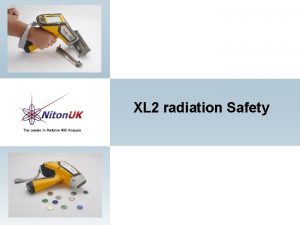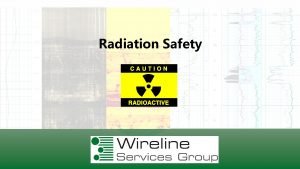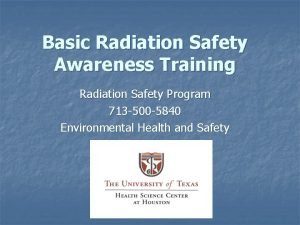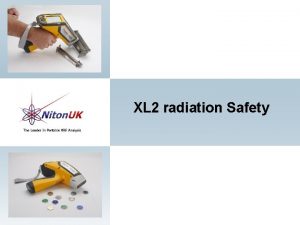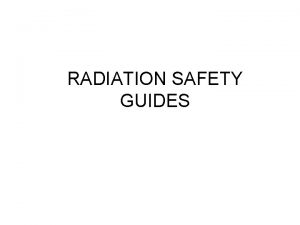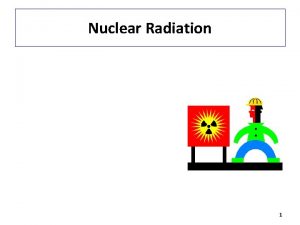Introduction to the Hospital Radiation Safety Konstantin Povod











































- Slides: 43

Introduction to the Hospital Radiation Safety Konstantin Povod, CHP, NRRPT Radiation Safety Officer, Clemson University

Medical Uses of Radiation Radiology: Radiography (imaging) with radiation producing machines Nuclear Medicine: Uptake, dilution, excretion, imaging, and therapy with unsealed material sources Radiation Oncology: Cancer therapy with sealed material sources and radiation producing machines

Types of Radiation X-ray producing machines: Primary Radiation Secondary Radiation Remnant Radiation Radioactive Material: Beta Gamma

I-131 Therapy All patients have had a thyroidechtomy; I-131 is administered to remove any remaining cancerous tissue I-131 is either in liquid or capsule form Typical dose is 100 -300 m. Ci Both external radiation (esp. 1 -st day) and contamination hazard present

I-131 Therapy: Room Posting

I-125 Eye Plaque Treatment of intraocular malignant and benign tumors I-125 seeds glued to a gold applicator (eye plaque) Typical dose is 20 -100 m. Ci External radiation only within several inches from the treatment site No contamination hazard

I-125: Eye Plaque Application

Y-90 Therapy Tiny polymer beads loaded with Y-90 No external radiation, once inside a patient Typical dose is ~ 30 - 90 m. Ci Possibility of contamination during dose preparation and delivery

Y-90 Therapy: Dose Delivery

Y-90 Therapy: Survey

Cs-137/Ir-192 Brachytherapy Sealed Cs-137 and/or Ir-192 sources Strong external gamma-radiation No contamination hazard

Types of Radiation (X-ray) Remnant Scatter Primary Leakage

Types of Radiation (X-ray) Primary – primary beam or useful beam is housed in a lead lined protective tube and is the source of radiation. This type of radiation is the most intense. The protective housing reduces leakage of radiation to less than 100 m. R/hr at a distance of 3 feet from the tube.

Types of Radiation (X-ray) Remnant radiation exits the patient and produces the image on the film. This type of radiation poses little threat to radiology personnel.

Types of Radiation (X-ray) Secondary - secondary radiation includes scattered and/or leakage radiation. This results when the primary beam interacts with the patient, or another object, and is deflected and partially absorbed. This radiation poses the highest risk of exposure for the room personnel.

Minimize Scatter Radiation ØTube Side ØDetector Side

Radiation Measurements Radiation dose to humans is measured in Sv (Sieverts) or rems (old unit). 1 Sv = 100 rem. Sv/rem measures the biological effect of radiation Occupational dose limits are usually expressed in micro-Sieverts or millirems. Doses capable of producing therapeutic effect or induce deterministic injury are measured in Grays (Gy) or rads (old unit). 1 Gy = 100 rad. Units of rem, Roentgen (R) and rad are approximately equivalent for X-rays

Deterministic Effects The effect occurs after a threshold dose has been exceeded The MAGNITUDE of the effect increases with increasing dose The effect can be directly attributed to radiation exposure Cataracts Cell Depletion in bone marrow Non-malignant skin damage Epiliation Lethality

Patient Radiation Injury 6 -8 weeks 16 -21 weeks 18 -21 months Patient underwent multiple coronary angiography and angioplasty procedures From Radiation-induced Skin Injuries from Fluoroscopy, Thomas B. Shope, Ph. D. , FDA, 2010

Deterministic Effects Tissue and Effect Single brief exposure * Highly fractionated exposures * Annual dose * Testes Temporary sterility Permanent sterility 15, 000 350, 000 -600, 000 NA NA 40, 000 200, 000 Ovaries Sterility 250, 000 -600, 000 >20, 000 Lens of eye Detectable opacities Cataracts 50, 000 -200, 000 500, 000 >800, 000 >15, 000 Bone Marrow Depression of hematopoeisis 50, 000 NA >40, 000 Skin Erythema Moist desquamation Tissue necrosis 300, 000 -500, 000 2, 000 5, 000 NA NA NA * All doses are in mrem

Stochastic Effects The PROBABILITY that an effect occurs is related to the magnitude of the radiation dose No relation between magnitude and severity of the effect – all or none response for an individual Same effect can be seen in unexposed individuals Cancer Radiation is a weak carcinogen Genetic Magnitude thought to be very small

Dose Response Curves Effect (cancer risk) Linear Non-Threshold (LNT) Model Confirmed Effects 5 rem: occupational dose limit “Acceptable” risk 5 ~50 rem Dose

Annual Radiation Dose Limits Total dose = 5, 000 mrem Total organ dose = 50, 000 mrem Lens of the eye = 15, 000 mrem Skin & Extremities = 50, 000 mrem Fetus = 500 mrem (50 per month)

Radiation Risk Estimates International Commission on Radiological Protection (ICRP) Publication 103 (2007) Nominal Risk for Stochastic Effects After Exposure to 1 Sv (1 Sv = 100 rem) at Low Dose Rates: Cancer 5. 5% (0. 055% per 1, 000 mrem) Heritable Effects 0. 2% (0. 002% per 1, 000 mrem) For acute exposures a factor of 2 is used for risk estimates U. S. Cancer death rate: 21. 20% (40. 6% total) With exposure to 5 rem: 21. 48%

Radiation Levels (mrem/year) 5, 000 TYPICAL RADIATION THERAPY: 5, 000 c. Gy = 5, 000 mrem TO SINGLE ORGAN (delivered in series of exposures)

Radiation Levels (mrem/year) 5, 000 500, 000 TYPICAL THERAPY X-RAY TO SINGLE ORGAN (series of exposures) LETHAL DOSE TO 50% OF HUMANS 400, 000

Radiation Levels (mrem/year) 5, 000 50, 000 500, 000 TYPICAL THERAPY X-RAY TO SINGLE ORGAN (series of exposures) LETHAL DOSE TO 50% OF HUMANS 400, 000 FIRST DETECTABLE PHYSIOLOGICAL EFFECTS 25, 000 16, 000 SMOKING 30 CIGARETTES PER DAY: 16, 000 mrem/year

Radiation Levels (mrem/year) 5, 000 500, 000 TYPICAL THERAPY X-RAY TO SINGLE ORGAN (series of exposures) OCCUPATIONAL EXPOSURE 50, 000 LETHAL DOSE TO 50% OF HUMANS 400, 000 FIRST DETECTABLE PHYSIOLOGICAL EFFECTS 25, 000 16, 000 SMOKING 30 CIGARETTES PER DAY 5, 000 MAXIMUM ALLOWED ANNUAL DOSE TO WORKER PART OF BODY ADULTS MINORS TOTAL AVERAGE ANNUAL RADIATION WHOLEDOSE BODY 500 mrem TO THE 5, 000 US mrem RESIDENT: 620 mrem SKIN EXTREMITIES 50, 000 mrem 5, 000 mrem LENS OF EYE 15, 000 mrem 1, 500 mrem N/A EMBRYO/FETUS (Declared Pregnancies) INDIVIDUAL MEMBERS OF THE PUBLIC - 100 mrem

Radiation Levels (mrem/year) Natural Background: 5, 000 50, 000 500, 000 Occupational: mrem (1. 1 5, 000 m. Sv)28 mrem 500 311 mrem 110 (3. 11 m. Sv) Medical Exposures: Education, Research Medical Cosmic in Air 300 mrem (3. 0 EPA Map of Radon Zones Absorbed Gamma Dose Rate 70 m. Sv) 80 11. 00% TYPICAL THERAPY X-RAY TO SINGLE ORGAN (series of Industry exposures) 80 LETHAL DOSE TO 50% OF HUMANS 400, 000 Nuclear FIRST DETECTABLE Radon-222 68% PHYSIOLOGICAL EFFECTS MAXIMUM ALLOWED ANNUAL DOSE TO WORKER AVERAGE NATURAL BACKGRD Government, AVIATION 311 310 Medicine Terrestrial 26% Military 300 Dental bitewing 60 7. 00% MEDICAL Interventional Chest Radiograph Fluoroscopy Radon-220 223 14% 5. 00% X-RAY DIAGNOSTICS Mammogram Aviation Potassium-40 RADON Conventional Head CT 310 5. 00% 200 Radiography and Power 190 Fluoroscopy Barium Enema NUCLEAR 190 Th & U Series AVERAGE 16, 000 POWER 11% ANNUAL 4. 00% SMOKINGOther 30 <0. 01% Chest or abdomen CT CT 147 RADIATION CIGARETTES NCRP Report 160, 2009 EXPOSURE NCRP Report 160, 2009 OCCU- 110 DAY NCRPJ. S. Duval Reportet. No. 160, 2009 PERradioactivity al, 2005, Terrestrial and. Coronary gamma-ray exposure. CT in the angiography TO U. S. PATIONAL RESIDENT US and Canada: U. S. G. S. Open-File Report 2005 -1413 Abdomen and pelvis 620 77 CT NUCLEAR Thallium myocardial MEDICINE perfusion CT Nuclear 49% 25, 000 < 10 mrem 10 -20 mrem 30 -60 mrem 100 -200 mrem 300 -600 mrem 500 -700 mrem 500 -1200 mrem 800 -1100 mrem 3500 -4000 mrem

Radiation Levels (mrem/year) Cosmic Radiation: 33 mrem (0. 33 m. Sv) Natural Radionuclides Contained In The Body: Terrestrial 28 mrem (0. 28 Terrestrial Radiation: 28 (0. 29 mremm. Sv) (0. 28 m. Sv) 29 mrem 5, 000 50, 000 Consumer Products: 13 mrem (0. 13 m. Sv) 500, 000 5, 000 TYPICAL THERAPY X-RAY TO SINGLE ORGAN (series of exposures) LETHAL DOSE TO 50% OF HUMANS Po-210 26% 400, 000 Commercial Th-232 Air Travel FIRST DETECTABLE 27% Building Materials PHYSIORa-228 LOGICAL EFFECTS 25, 000 MAXIMUM ALLOWED ANNUAL DOSE TO WORKER Rb-87 AVERAGE NATURAL BACKGRD 311 AVIATION 310 and K-40 6% Mining Agriculture 300 MEDICAL 2% Fossil Th-230 Fuels 223 0. 6% Road Construction X-RAY DIAGNOSTICS <0. 03% Glass & Ceramics 200 190 NUCLEAR POWER U-238 J. S. Duval et al, 2005, Terrestrial in Tobacco SMOKING 30 radioactivity and gamma-ray exposure CT 147 the US and Canada: U. S. G. S. Open-File Report 2005 -1413 CIGARETTES PER DAY COSMIC 33 INTERNAL R/N 29 TERRESTRIAL 3% Other. RADON 35% Rn-222 16, 000 50 OCCU- 110 Ra-224 C-14 J. S. Duval et al, 2005, Terrestrial radioactivity and gamma-ray exposure PATIONAL NCRP Report 160, 2009 in the US and Canada: U. S. G. S. Open-File Report 2005 -1413 77 NUCLEAR MEDICINE 21

Radiation Levels (mrem/year) 5, 000 50, 000 500, 000 TYPICAL THERAPY X-RAY TO SINGLE ORGAN (series of exposures) 5, 000 NATURAL GAS: LETHAL DOSE TO 50% OF HUMANS MAXIMUM ALLOWED ANNUAL DOSE TO WORKER 500 5 50 2 AVERAGE (especially NATURAL residential use) 400, 000 BACKGRD 311 AVIATION 310 300 FIRST DETECTABLE MEDICAL PHYSIOLOGICAL EFFECTS COSMIC 33 INTERNAL RN 29 223 X-RAY DIAGNOSTICS 25, 000 FALLOUT FROM WEAPONS RADON 200 TESTING: 0. 75 190 16, 000 SMOKING 30 CIGARETTES PER DAY TERRESTRIAL 21 NATURAL GAS (especially residential) 2 NUCLEAR POWER 147 CONSUMER PRODUCTS OCCU- 110 PATIONAL 13 CT 77 NUCLEAR MEDICINE WEAPONS FALLOUT 0. 75 SLEEPING WITH ANOTHER HUMAN 0. 1

Radiation Dosimeters (“Badges”) Dosimetry badge must be worn between the waist and collar Your badge must remain at work. Only wear YOUR issued dosimeter. Store out of radiation sources. Badges are replaced quarterly.

Dosimetry Badges Outside or Under ? If only one badge is used, it has to be worn at neck level above protective garments in order to provide an estimate of the dose to the lens of the eye, besides an (over-) estimate of the whole body dose

Dose Control Dosimetry badges are evaluated quarterly by an offsite agency (Mirion), the reports are mailed to the Clemson radiation safety office Copy of these reports are sent to each department Employees are notified if levels exceed allowable amounts.

Dose Report

ALARA As Low As Reasonably Achievable ALARA level 1 (10% of the occupational limit) - employee contacted by a letter to review their work practices ALARA level 2 (25%) - employee notified by letter and must respond to radiation safety office with possible explanation of elevated radiation exposure

Factors Affecting Radiation Dose Time. Radiation Dose is inversely proportional to the Radiation Dose directly proportional to the Heavier materials lead) better Contamination isdistance a(eg. , source of provide both square of theis from the external source. exposure shielding from X-ray radiation and internal contamination Distance INcreases x 2 ->time Dose DEcreases x 4 Distance INcreases x 3 -> Dose DEcreases x 9 Distance. Shielding. Contamination Control

Distance Interventional Vascular Equipment, 7. 5 pulses/sec

Shielding

Care of Lead Aprons Lead aprons should always be hung up after each use to maintain integrity of the lead. Inappropriate storage of lead aprons may result in damage to the lead and increase radiation exposure.

Active Radiation Awareness Yellow lights above monitor Warning sign outside room

Pregnant Staff If you’re pregnant, you should complete a confidential “Voluntary Notification of Declared Pregnancy” form, to be issued an additional dosimeter. It should be worn under the lead apron to monitor possible exposure to the fetus. Dose limit to the fetus equals to 500 mrem per all 9 -month gestation period, with a monthly limit of 50 mrem.

Radiation Safety Contacts 656 -3516 kpovod@clemson. edu
 Posljedice seobe naroda
Posljedice seobe naroda Odisej trojanski rat
Odisej trojanski rat Krimski rat karta
Krimski rat karta Grčko-persijski ratovi
Grčko-persijski ratovi Radiation safety
Radiation safety Radiation safety
Radiation safety Radiation safety
Radiation safety Tungsten inclusion in rt film
Tungsten inclusion in rt film Organisation of hospital pharmacy
Organisation of hospital pharmacy Ushinskiy didaktikasi
Ushinskiy didaktikasi Konstantin boldin
Konstantin boldin Dr. konstantin ziolkowski
Dr. konstantin ziolkowski Konstantin busch
Konstantin busch Matus kucera konstantin a metod
Matus kucera konstantin a metod Konstantin zioutas
Konstantin zioutas Recursion algorithm
Recursion algorithm Dr. konstantin ziolkowski
Dr. konstantin ziolkowski Dr konstantin nikitin
Dr konstantin nikitin Romeo in julija oznaka oseb
Romeo in julija oznaka oseb Konštantín porfyrogenetos
Konštantín porfyrogenetos Hyperbolic geometry of complex networks
Hyperbolic geometry of complex networks Konstantin der grosse naissus
Konstantin der grosse naissus Konstantin busch
Konstantin busch Konstantin stanislavski born
Konstantin stanislavski born Konstantin boyarsky
Konstantin boyarsky Konstantin zouboulis
Konstantin zouboulis Konstantin stanislavski parents
Konstantin stanislavski parents Konstantin ustinovich chernenko
Konstantin ustinovich chernenko Konstantin porfirogenet
Konstantin porfirogenet Konstantin stanislavski born
Konstantin stanislavski born Konstantin kudryashov
Konstantin kudryashov Konstantin meyl
Konstantin meyl Ohlinger
Ohlinger Aab ccb
Aab ccb Konstantin car
Konstantin car Konstantin stefanov
Konstantin stefanov Gwpaw
Gwpaw Konstantin matchev
Konstantin matchev Konstantin tjernenko
Konstantin tjernenko Konstantin alekseyevich korovin
Konstantin alekseyevich korovin Konstantin busch
Konstantin busch Konstantin ivanov nmr
Konstantin ivanov nmr 2013 hospital national patient safety goals
2013 hospital national patient safety goals Hospital safety index adalah
Hospital safety index adalah




